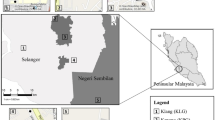Abstract
We examined the pattern of species composition of breeding birds along urban-rural gradients in the Osaka Prefecture, western Japan. We recorded the proportion of nine types of land-use and the presence/absence of each of 76 breeding birds in 5 km square quadrats on a map of the Prefecture. The proportion of woodland and farmland which increased from urban to rural areas were two major enviornmental gradients according to Principal Component Analysis of the nine types of land-use. Ordination by Canonical Correspondence Analysis (CCA) showed that the breeding bird distribution differentiated along the two major clines, woodland and farmland. The avifauna changed successively along these environmental gradients. There were no discrete boundaries of the distribution of bird species groups. We tentatively classified five groups of quadrats on the ordination plane of the sample score. The geographic position of these five groups on a map preserved the environmental gradient, but showed that water (seashore and river) was a stronger influence on bird species composition than land-use pattern. Although the diversity of land-use seemed to raise species richness in the third group, the less diverse, woodland-rich group contained as many species as the third group. Four groups of bird species, and one group in which species occurred in more than 90% of the quadrats, were classified in the CCA-ordination plane. The occurrence of these bird groups correlated with land-use; the first group with woodland area, the second with scatter woodland, the third with farmland and the fourth with seashore.
Similar content being viewed by others
References
Andrewartha H. G. &Birch L. C. (1954)The Distribution and Abundance of Animals. University of Chicago Press, Chicago.
Clements F. E. (1916)Plant Succession: an analysis of the development of vegetation. Carnegie Inst. Washington Pub. No. 242., Washington.
Hansen J. &Urban D. L. (1992) Avian response to landscape pattern: the role of species' life histories.Landscape Ecology 7: 163–180.
Higuchi H., Tsukamoto Y., Hanawa S. &Takeda M. (1982) Relationship between forest area and the number of bird species.Strix 1: 70–78.
Hill M. O. (1974) Correspondence analysis: a neglected multivariate method.Applied Statistics 23: 340–354.
Hill M. O. &Gauch H. G. (1980) Derrended correspondence analysis: an improved ordination technique.Vegetario 42: 47–58.
McDonnell M. J. &Picketts S. T. A. (1990) Ecosystem structure and function along urban-rural gradients: an unexploited opportunity for ecology.Ecology 71: 1232–1237.
Numata M. (1976) Methodology of urban ecosystem studies. In:Science for a Better Environment. Proccedings of the International Congress on the Human, Environment (1975, Kyoto) pp. 221–228. HESC, Tokyo.
Owen J. G. (1990) An analysis of the spatial structure of mammalian distribution patterns in Texas.Ecology 71: 1823–1832.
Patterson B. D. &Atmar W. (1986) Nested subsets and the structure of insular mammalian faunas and archipelagos.Biological Journal of the Linnaean Society 28: 65–82.
Soule M. E., Bolger D. T., Alberts A. C., Wright J., Sorice N. &Hill S. (1988) Reconstructed dynamics of rapid extinction of chaparral-requiring birds in urban habitat islands.Conservation Biology 2: 75–92.
Taylor B. (1991) Investigation species incidence over habitat fragments of different areas — a look at error estimation.Biological Journal of the Linnaean Society 42: 177–91.
Ter Braak C. J. F. (1986) Canonical correspondence analysis: a new eigenvector technique for multivariate direct gradient analysis.Ecology 67: 1167–1179.
Ter Braak C. J. F. (1987)CANOCO — a FORTRAN program for community ordination by [partial] [detrended] [canonical] correspondence analysis, principal components analysis and redundancy analysis. Version 2.1. III-TNO, Wageningen.
Ter Braak C. J. F. (1990)Update notes: CANOCO version 3.10. Agricultural Mathematics group, Wageningen.
The Bird Society of Japan, Osaka Branch (1988)Birds in Osaka 5. Osaka Prefectural Government, Osaka.
Whittaker R. H. (1967) Gradient analysis of vegetation.Biological Review 42: 207–264.
Author information
Authors and Affiliations
About this article
Cite this article
Natuhara, Y., Imai, C. Spatial structure of avifauna along urban-rural gradients. Ecol. Res. 11, 1–9 (1996). https://doi.org/10.1007/BF02347814
Received:
Accepted:
Issue Date:
DOI: https://doi.org/10.1007/BF02347814




